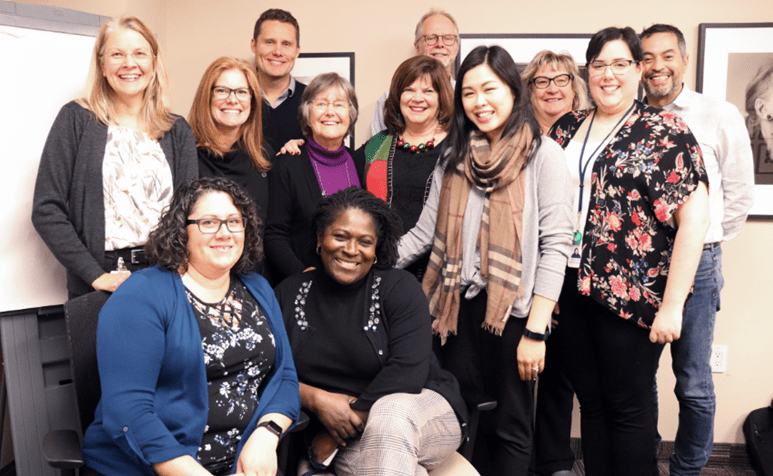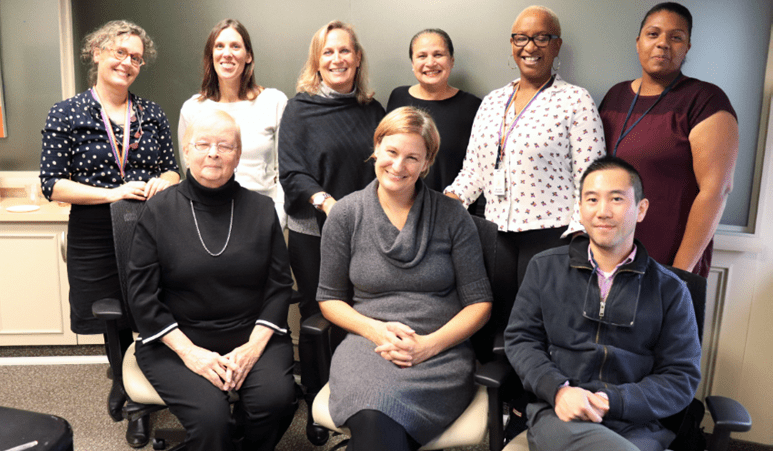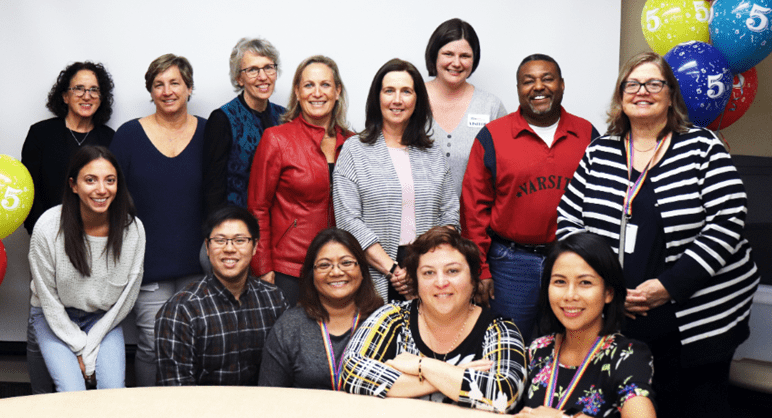Dedication, Sweat & Flexibility: Three Steering Committees Collaborate with Client Partners to Deliver a Roadmap for Change

Through changing portfolios, staff changes and shifting priorities, VHA stayed dedicated to the work of the three Steering committees focused on improving services for key client populations.
It was a tall order from the beginning – do the research, identify the priorities, and then collaborate with stakeholders to create a roadmap for the future for VHA’s delivery of services to three significant client population areas. Oh, and do it all in five years.
This is what three steering committees were asked to do when they were initially formed in 2015.
The committees were a natural outgrowth of the 2015-2019 VHA Strategic Plan, which called for dedicated action around three population areas: Palliative Care, Children with Complex Medical Needs (CCMN), and Cognitive Impairment. For each of the committees, this was an exciting opportunity to tackle the gaps in key service areas and deliver concrete change.
The close of 2019 signaled the end of that strategic plan and along with it, the wrap-up of these committees.
In their own way, each of the committees evolved to meet the challenges before them. “We realized we had to be flexible,” says Matt Wong, CCMN Committee Co-Chair and a Professional Practice Specialist. Changing portfolios, staff changes, and shifting priorities contributed to the pressure but didn’t distract the teams from putting their heads down and getting the work done.
While the committees might have felt a huge responsibility to improve the delivery of care – and that was definitely a big part of it – according to Catherine Chater, Chair of the Cognitive Impairment Committee and a Professional Practice Specialist in Rehab, there were really two key stakeholders: “The intent to provide excellence in care cuts across two angles,” she said. “One being the direct care that we provide as an organization, making sure that’s aligned to best practices. And then, because the caregiver has such a profound role, particularly for dementia and the community, being able to support the caregiver and what they’re doing was a core component of the work.”
Learning and growing was two-way
The composition of the committees was designed to be interdisciplinary. “The idea of having a diversity of ideas and experience in the room was very beneficial, and that included having client partners as integral contributors,” says Matt. “The learning and growing was really two-way throughout the process.”
Client partners were embedded with each committee, and the clients’ lived experience with palliative care, children with complex medical needs, and cognitive impairment gave committee members crucial lessons in what was needed in the field and the client partners were also dedicated to developing practical solutions.
“One of our client partners really advocated for the PSWs,” said Professional Practice Specialist (Nursing & PSW) and Palliative Steering Committee Co-Chair Janet Chan. “She identified some gaps in preparing the PSWs for MAiD (Medical Assistance in Dying) and with her feedback, we were able to create a video for the PSWs on what to expect with MAiD.” Another client partner proved to be a key resource in creating the VHA Palliative Care website.
Catherine emphasized how client partners were key drivers of the work. One client partner on the committee had been a caregiver for two people with dementia and figured out a useful way to engage with PSWs. “She set up a communication log with the PSWs who were coming into her home, and that log is now part of the formal VHA activation toolkit,” said Catherine. Another is a nurse by training who also cared for someone with dementia. She looked for new approaches and discovered a program that is already changing dementia care in Canada: the Butterfly Model of Care. “With Physiotherapist Brandi D’Souza’s help, we were able to secure a $35,000 grant from the Spark Initiative (https://www.cabhi.com/the-spark-program) and that was the seed funding needed to build the Emotion-Focus Activation Program, which is our version of the Butterfly Model,” says Catherine.
“Activation is already a core part of what the PSWs are doing, but the inclusion of this model has really moved our thinking in a different direction,” she adds.
The collaborative spirit of the committees and their inclusion of client partners delivered more than new treatment approaches – Janet says they had a positive emotional impact as well. “For our client partners who had just lost family members, they said joining the committee gave them a new family and they found purpose again,” said Janet. “One was proud that she could show her daughter that life goes on and you can still contribute.”
Palliative Steering Committee’s Key Strategic Outcomes
● Several MAiD projects: “MAiD in Their Eyes” video; MAiD page on VHA’s intranet; MAiD education sessions for nurses and PSWs; MAiD rehab sessions; and a MAiD brochure
● Created a bereavement toolkit and continuing education for palliative staff
● Developed a palliative orientation pathway after surveying palliative nurses on education needs

● Palliative Interdisciplinary Educational Symposium event launching in 2020
● Palliative PSWs are supported in attending palliative conferences
● Rolled out a new Palliative phone number, dedicated exclusively to palliative patients; call agents are being trained to hasten nurse-client connection
● Palliative care website launched and is being regularly updated
Implemented pilot survey of 30 clients and areas of concern were addressed – calls will be ongoing and recommendations considered for action
● Developed Palliative Care brochure
● Client, family and staff palliative stories featured in Palliative Newsletter
The Connected Care Circle grows
As they considered new ideas and solutions, the committees were grappling with how to roll them out with minimal resources. “There are so many great initiatives out there, but figuring out how to deliver education and new programs without big budgets was definitely a challenge,” said Catherine. The challenge was quickly overcome with some creative thinking and forging stronger relationships with research partners. Catherine cites the Spark Grant as one creative solution. Another came through the development of an education and support program for community and home care nurses called Connected Care.
“We talked to Sick Kids Hospital because they are usually the first touch point for parents with children with complex medical needs,” says Matt. Sick Kids was happy to share their processes and took it one step further with the development of Connected Care, a larger partnership of close to 18 organizations (among them: Holland Bloorview, Emily’s House and VHA) who together have created a forum for discussion about emerging needs and educational workshops for community and home care nurses.
“This is an important example of how we worked within our mandate to strengthen organizational and research partnerships,” says Matt.
With dementia patients, words fail, but research has shown that music provides a way for them to connect with past memories and emotions. A connection was made with The Alzheimer Society, which was looking for a way to expand its Music Project. “We partnered with them and they provided no cost MP3 players loaded with personalized music for our clients,” said Catherine. “Our best documented feedback came from the Music Care program, which contributed to reduced responsive behaviors, emotional regulation, and general feelings of well-being for both caregivers and clients.”
Breaking down siloes was never a deliberate goal of the committees, but according to committee leads, they now consider it one of the most powerful side effects.
Cognitive Impairment Committee’s Key Strategic Outcomes
● Use the power of music to help people with dementia: distribution of free MP3s with personalized music
● Multi-tiered training for PSWs, OTs, rehab specialists and supervisors to support clients with dementia and manage responsive behaviours
● Built the Emotion Focus Activation Program, and with a Spark grant, expanded into an e-module for caregivers in the community

● With a client partner, developed a communication log that is now part of the VHA activation toolkit
● Development of a website for caregivers of people with dementia
● Implementation of training programs for care team supervisors when they come on board and You First external training for direct personnel like PSWs
PIES delivers the perfect learning experience
Nothing says inter-professional collaboration better than the creatively-titled education forum developed for staff by the CCMN steering committee – PIES or the Paediatric Interdisciplinary Educational Symposium. “In home care it’s very easy to become siloed,” said Matt, “and so we thought, why not bring all the nursing providers working with children with complex needs together in a safe space and share our challenges, strategies and successes?”
PIES included keynotes and presentations as well as hands-on opportunities to work together. This year medical directors from Sick Kids and Emily’s House were invited to speak as well as client partners. The Palliative Care Steering Committee was watching from the sidelines and was soon lobbying for its own version of a PIES day. “We saw the benefits of an education session focused on bereavement and caregiver support and are now working on taking the structure and format and adapting it to our own adult palliative population,” said Janet.
Even though the committees have ‘sundowned’, the VHA Best Practice Research and Education Department under the direction of Kathryn Nichol, who is also the senior sponsor of the CCMN committee, is picking up the ball and has committed to continue PIES. “We’re really glad the value of this kind of hands-on learning and interaction is recognized and will continue,” said Matt.
Janet added, “These projects demonstrate the importance of the team dynamic and including all disciplines in palliative care, as well as the perspective of the caregiver. Getting these things done is really something to be proud of.”
For any one of the leads of the committees, their greatest satisfaction is the knowledge that the work is going to persist. “What we’ve created as committees, together with our organizational and client partners, is now embedded within the organization and is certainly going to continue,” says Matt. “That is what makes us proud.”
None of it was easy, which made the high level of engagement from those who participated in the Steering Committees and spin-off sub-committees all the more impressive to the committee chairs. “We were able to tap into the specific knowledge of individuals and then keep it part of an overall bigger container,” said Catherine. “The best part was being a witness to this remarkable group of people who have different areas of expertise.”
“Throughout the process, we embraced different voices and different points of view,” adds Matt. “It was a very open, sharing atmosphere, which is consistent with the VHA culture. I’m so proud that everyone was really dedicated to doing this work.”
Children with Complex Medical Needs Committee’s Key Strategic Outcomes
● Expanded services to focus population after consultation with client partners-creation of a summer program provided at no charge for children with complex medical needs
● Expanded research partnerships with Holland Bloorview (HB) and Sick Kids-creating touchpoints with nurses at HB and managing transitions; partnering with Sick Kids to tweak our policies to reflect continuity across the different health care organizations

● Partnered with several organizations in the creation of the Connected Care support programs for home care nurses and piloting the education modules
● Enhanced inter-professional collaboration and education through development of the PIES (Paediatric Interdisciplinary Educational Symposium) – has now run for 3 consecutive years
● Two-day extended paediatric education component developed and added to CFN Nurses’ Orientation
● Developed an individualized numeric pain scale for paediatric non-verbal pain management
